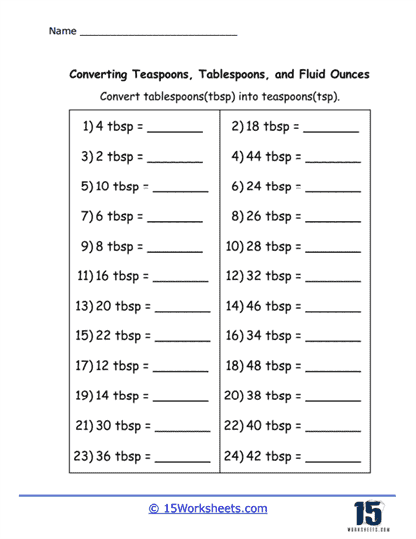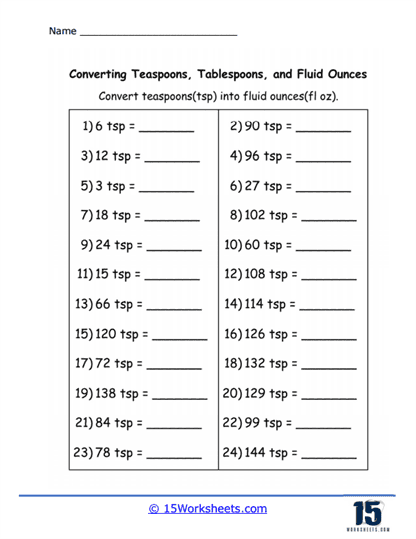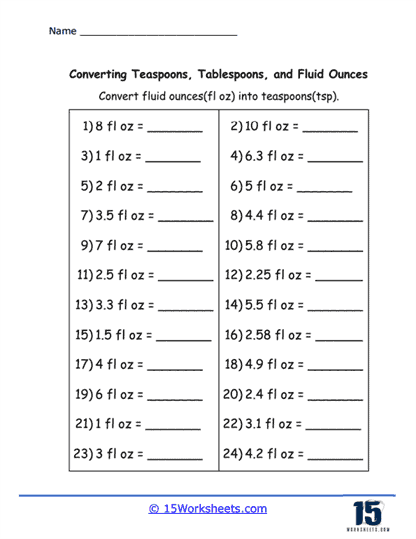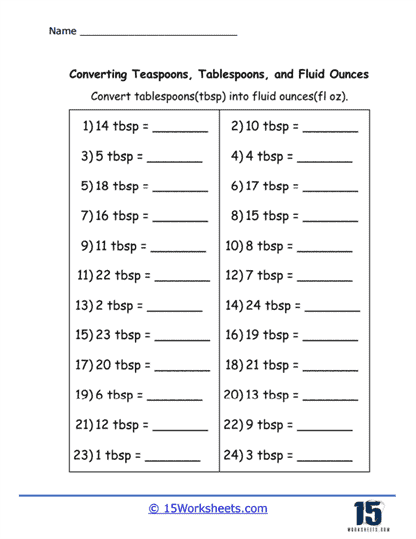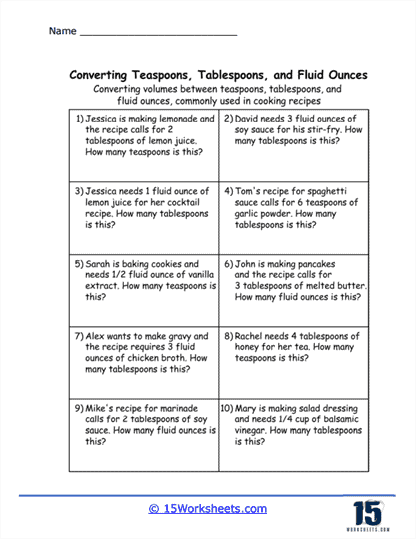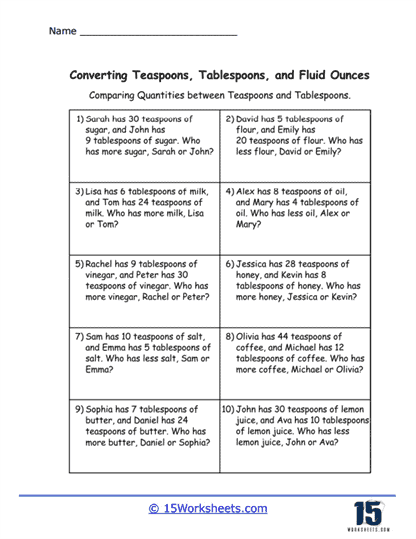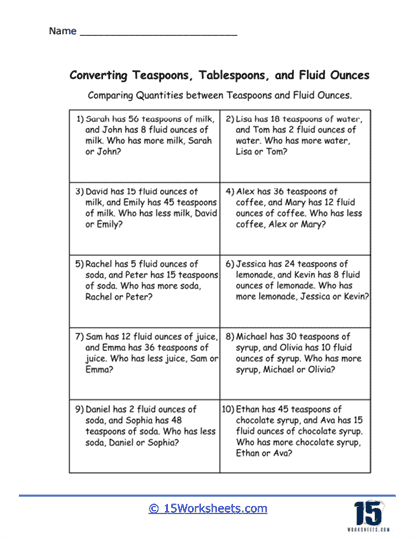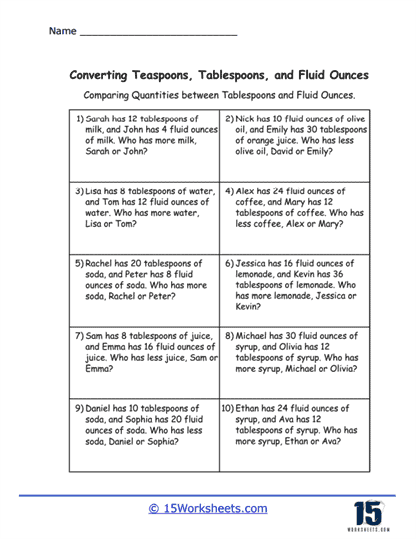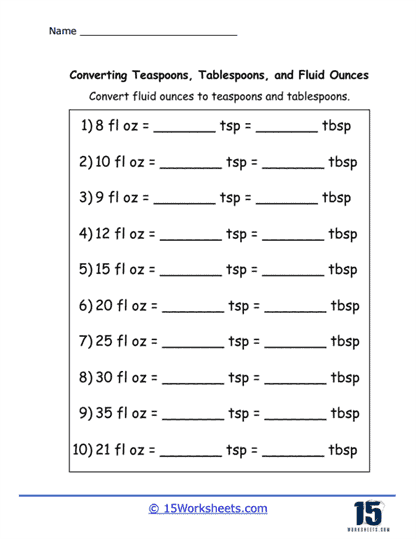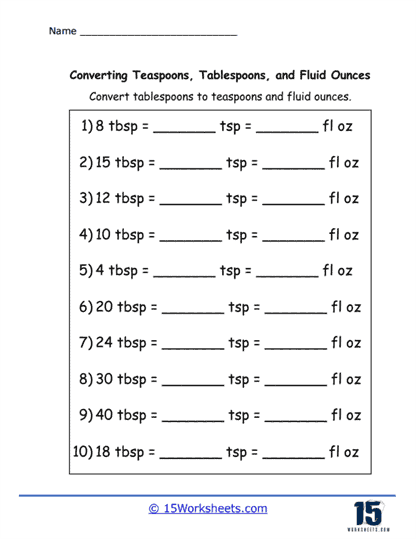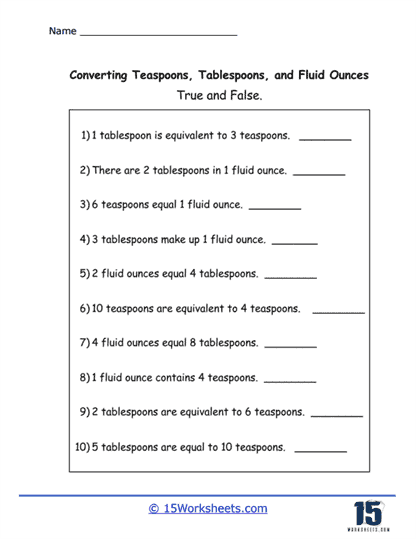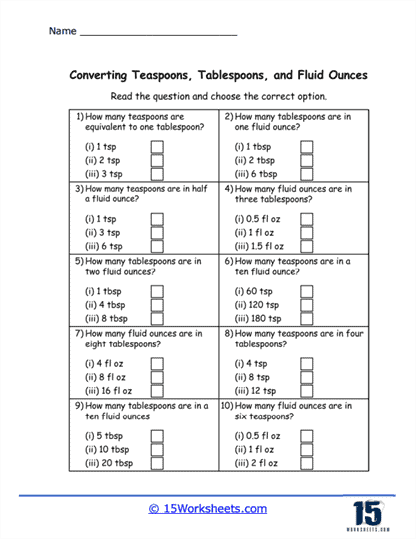Teaspoons, Tablespoons, and Fluid Ounces Worksheets
About These 15 Worksheets
Teaspoons, tablespoons, and fluid ounces are units of volume used primarily in cooking and baking, but they also find application in educational contexts, particularly in worksheets designed to teach measurement concepts. These worksheets are educational tools that help students, especially those in elementary and middle school, understand and practice volume measurement and conversion between these units. The exercises on these worksheets vary in complexity and format, catering to different age groups and learning levels.
Types of Exercises
1. Basic Identification and Understanding
These worksheets start with exercises that help students identify the different measurement units and understand their practical uses. For example, students may need to match pictures of measuring spoons and cups with their corresponding units. Another common exercise involves describing scenarios where these units are used, such as measuring medicine in fluid ounces or adding three teaspoons of sugar to a recipe.
2. Conversion Exercises
Conversion exercises are a core component of these worksheets. They require students to convert between teaspoons, tablespoons, and fluid ounces. This might involve straightforward conversion tasks, such as converting 6 teaspoons to tablespoons, or more complex ones that require converting fluid ounces to tablespoons in the context of a recipe. These exercises help reinforce basic arithmetic skills and provide a practical understanding of how these measurements relate to each other.
Word problems integrate real-world scenarios, compelling students to apply their knowledge of measurement units in practical contexts. A typical word problem might describe a cooking scenario where a recipe requires certain measurements of ingredients in different units, and students must figure out how to adjust the recipe quantities accordingly. These problems enhance critical thinking and problem-solving skills, as students must decide not only how to calculate the answers but also how to interpret the questions correctly.
3. Filling Recipes
These exercises present students with incomplete recipes where certain measurements are missing, and they must fill in the correct amounts using the appropriate units. This type of exercise tests students’ understanding of the relationship between units and their ability to apply this knowledge in a practical task.
Some worksheets incorporate interactive elements, such as diagrams of measuring cups and spoons that students need to label or mark with the correct measurements. Alternatively, students might be asked to draw their own diagrams to demonstrate different measurements. These exercises are particularly useful for visual learners and help reinforce the spatial understanding of volume.
4. Comparison and Estimation
Comparison exercises may ask students to rank several containers or quantities from least to most in terms of volume, using the units of teaspoons, tablespoons, and fluid ounces. Estimation exercises challenge students to guess the volume of common items or ingredients before actually measuring them. These types of exercises develop analytical and estimation skills, which are critical in everyday decision-making.
To bridge classroom learning with real-world application, some worksheets might require students to carry out small experiments or cooking projects. For example, students could be asked to use teaspoons and tablespoons to create a mixture of water and vinegar for a science experiment or to bake a simple recipe using the exact measurements from the worksheet.
These exercises integrate other subjects such as science or health education. For instance, students might calculate the fluid ounces of water needed per day based on a person’s weight or determine the amount of each ingredient needed for a chemical experiment, thus applying their math skills to scientific or health-related contexts.
When Do We Use These Units In The Real World?
Teaspoons, tablespoons, and fluid ounces are units of volume primarily used in the United States and some other countries that have not adopted the metric system fully. These units are part of the U.S. customary system and are widely used in both everyday life and professional settings, mainly related to cooking, baking, and serving food and beverages. Each of these units has specific applications depending on the context and the level of precision required.
Teaspoons are a small unit of volume, equivalent to about 4.93 milliliters. In the culinary world, teaspoons are essential for measuring ingredients that are used in smaller quantities but have a significant impact on the outcome of a recipe, such as spices, baking powder, baking soda, or yeast. The precision offered by teaspoon measurements is crucial in baking, where exact chemical reactions are necessary for desired results. Outside of cooking, teaspoons are also commonly used to measure medicine doses. Liquid medications often come with dosing instructions and devices marked in teaspoons to ensure accurate administration, particularly for children.
Tablespoons represent a larger volume, equivalent to three teaspoons or about 14.79 milliliters. This measurement unit is frequently used in cooking to measure both liquid and dry ingredients, such as oils, vinegars, and herbs or spices that are needed in larger quantities than what is typically measured with a teaspoon. Tablespoons are also a standard unit for serving sizes in recipes, especially for condiments like butter or sugar. In the realm of bartending, tablespoons are used to measure ingredients for mixed drinks, ensuring each cocktail is precisely crafted.
Fluid ounces are another step up in volume, equivalent to approximately 29.57 milliliters. This unit is indispensable in many beverage-related contexts. For instance, in coffee shops, fluid ounces dictate the sizes of beverages, ensuring consistency across servings. In recipes, fluid ounces are used to measure larger quantities of liquids, such as water, milk, or broth. The unit is also crucial in nutrition labeling, where fluid ounces help quantify the volume of liquid products, providing a clear indication of serving size for consumer understanding and health regulation compliance.
These measurement units are not just practical; they are part of a cultural fabric in regions where traditional recipes and household practices pass down through generations using these customary units. For example, family recipes often specify ingredients in teaspoons, tablespoons, or fluid ounces, which speaks to the historical continuity and cultural heritage associated with cooking and baking practices.


